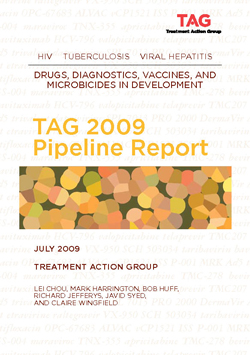HIV, Tuberculosis, and Viral Hepatitis: Drugs, diagnostics, Vaccines, and Microbicides in Development
July 2009
By Lei Chou, Mark Harrington, Bob Huff, Richard Jefferys, Javid Syed, and Claire Wingfield
TAG’s annual Pipeline Reportsurveys the developments in medicines and diagnostics most likely to improve the lives of people living with HIV, viral hepatitis, and tuberculosis within the next few years. But in spotlighting what is in the pipeline, the report also identifies critical gaps where research is falling short of the need for better tools to manage these diseases.
From the Introduction:
This year’s Pipeline report shows, in brief, a lull in anti-HIV drug development, an alarming stasis in hepatitis B treatment research, renewed activity (after a gap of almost 40 years) in TB drug development, agonizing slow and incremental progress in TB diagnostics research, very preliminary human studies of several new TB vaccine candidates, a back-to-basics mood in the HIV vaccine research community, renewed hopes for efficacy in microbicide and pre-exposure prophylaxis, and no dramatic developments in the areas of immune-based therapies or therapeutic vaccines for HIV.
In short, as Thomas Kuhn would have said, this report documents a period of relatively “normal” science, with its incremental steps forward and back, its halting progress, its occasional retreat from a blind alley. There is nothing as dramatic here as the bleak pessimism that enshrouded HIV vaccine research after the STEP study was prematurely terminated in 2007, nor the possibly overhyped HAART 2.0 breakthrough of that same year, when two new classes of anti-HIV drugs were introduced. Yet, as Richard Jefferys points out in the conclusion to his chapter herein, the despair of Berlin 1993 preceded the euphoria of the HAART revolution of Vancouver 1996 by just three years. We do not have a crystal ball; nor do we know whence the next breakthrough may come.

